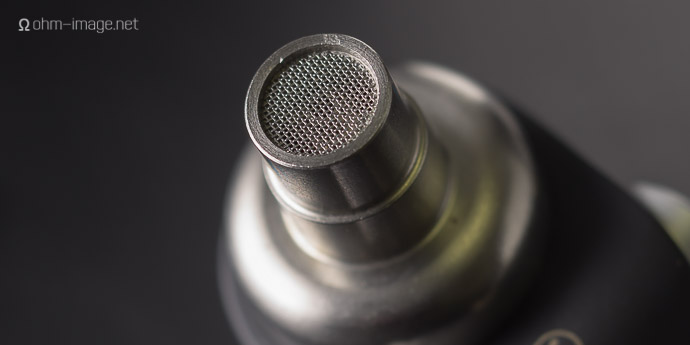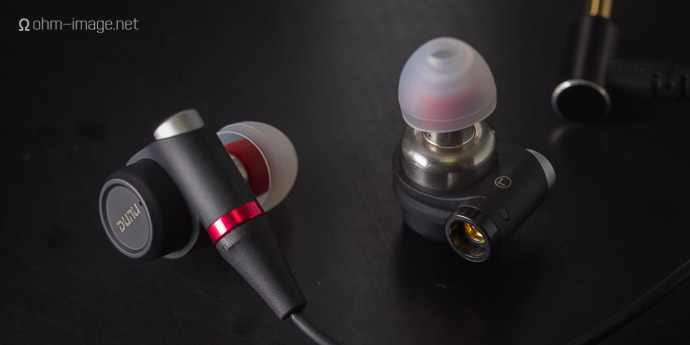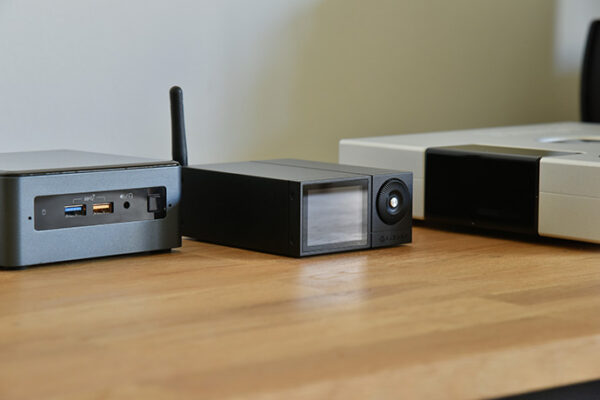Sound
The DN-2002’s neutral frequency response, warmth, couple with a good dollop of DN-2000j contrast. It’s also got a more laid back bass than either Titan 3 or 5. The DN-2002’s mids are warmer, cast further forward, and sit wider than those found in the 2002j. Because of this, I find it easier to pair the 2002 with a wide variety of music. It drives more smoothly into highs than does the DN-2000j, which tends toward sibilance. Despite lower pressure in the high mids and lower highs, its sound stage – as described by the midrange- appears larger, with clearer median delineation. That doesn’t mean that it sounds wider. Rather, the z-axis jumps more to the fore; in it strings, vocals, etc., are given ample lateral room. Because highs are more laid back, stage width as described by contrast-to-mids highs and lows, is more constrained.
The 2000j is fun for casual electronic genres, but its mids are too reedy for jazz and vocals, whose rich mid sections benefit greatly from warmth and breadth, which are hallmarks of the DN-2002. Nick Cave’s piano ballads anchor through the midrange. The DN-2000j’s cymbals may shimmer harshly. The DN-2002 presents godly, controlled, and extended percussion which sweetly sidesteps sibilance whilst hanging a thin, sugary veneer.

The transition zones are described by subtle gradients. Lows, whose overall sound pressure has been rolled back vis-a-vis the DN-2000j, are airy. The image is round, diffuse, and decently detailed. In no way are lows the equal of anything from Ocharaku’s Flat4 series. Bass doesn’t yawn with the pressure in Markuz Schultz’s Mainstage. Stereo detail in bass is large, and so is stage width. At times, bass elements stretch way past the shoulders.
I’m of two minds with regards to trance. The DN-2002’s essential flavour and neutral mix, are perfect for the genre. Even its gentle transition from high mids to highs is spot on. I couldn’t wish for anything better. But with certain pop-heavy, multi-layered trance compositions, bass/mid timing is off by a small fraction. It’s enough to fatigue in Paul Van Dyk’s latest, but almost perfectly plays to pre-2008 trance.
Imaging is more precise than both Radius’s TWF41 and TWF31, defined in large part by clearer instrument placement. Strings, percussion, and vocals occupy distinct, but smoothly-defined niches. Surprisingly, despite a higher contrast curve than either Radius, the DN-2002 is almost as stereo natural.
Against my other favourite hybrid:
One of the Ultrasone IQ’s biggest drawbacks is ear tip selection. What it comes with sounds crap. The DN-2002 comes with a wonderful selection of tips that sound, and fit, great. Both earphones can sound natural, but the IQ tips more energy into the high range; and by comparison, mildly suppresses the midrange. Here and there, both botch bass: the IQ tending to bottom out; and the DN-2002, when paired with fast genres, suffering slight timing errors. It is my opinion that the DN-2002 is the easier earphone to throw into a good setup. It hisses less. Amps with poor left/right channel balance have more room to adjust volume.
But when it comes down to it, it really is all about ear tips. And while the DN-2002 doesn’t fit as securely, it is less fiddly to integrate into an already good system. It is also less precious. Don’t its price fool you. Personally, I think the DN-2002 has an edge.
End words
The DN-2000j is a guilty pleasure of mine. It shows what could be done with a new-age hybrid. But its highs can be sibilant. And bass, which pressed too firmly against a mild midrange, crowded out z-axis stage detail. The DN-2002 fixes all of that. No contest. It is the more natural sounding earphone. It is one of the most natural sounding earphones I’ve listened to this year. It is tough, and comes with a great accessory set. The DN-2002’s cable isn’t great, and its deep mounting flange is hard to pair with third party options.
But make no mistake, it is one of the best-sounding earphones at any price, and perhaps the most natural sounding hybrid on the market.










Barun C
Nice article Nathan. The overall design and connector is reminiscent of the Sony Ex-1000, Ex-800 ST & 600 series. The concluding statement is a big one, so I had a couple of questions.
1. How is the isolation of these, will you recommend them for outside listening?
2. How competitive are the DN 2002, when going head to head with another hybrid, Lear BD
4.2?
3. In terms of value, would you say that DN 2002 edges the Andromeda as well, considering
Andromeda is now being hailed as a benchmark for UIEMs, which can go toe to toe with
any TOTL CIEM?
ohm image
Hello Barun,
Indeed, the design evokes earphones we’ve seen in the past. With the exception of timing steps in fast, modern trance and heavy metal, this earphone really hits above its weight.
1. Isolation is good, but will depend a lot on your ears and the tips. It’s not as good as a CK10 or ER4.
2. The BD4,2 is more laid back, and has smoother transitions, but only just so.
3. Andromeda is the most non-BA sounding BA earphone I’ve used, and plays very well against Noble’s K10. While the DN-2002 and Andromeda aren’t sound-compatible, I’d give personal edge to Andromeda because it suffers no timing shifts.For me, the DN-2002 is more comfy.
The DN-2002 is extremely good.
Barun C
Those are words of extreme praise. This is very interesting, wish I had both the Andromeda and Dunu DN 2002 to audition and find out how they stack against my recent venture into CIEM, the Custom Art Harmony 8.2.
Aras
Nathan, is this a fine upgrade from Velvets in warm mode? I’m looking for something slightly softer highs than Velvets but with bass just as strong. Any recommendations?
ohm image
The DN2002 is more detailed than the Velvet in any mode and its bass is generally neutral.
Mr. Carvalho
Nice review.
How does it compares to DN-2000?
ohm image
It is less harsh in the top end, better fitting, with a calmer, more neutral bass to mids transition. Better in every way- at least as I define better.
Tim
“It is less harsh in the top end, better fitting, with a calmer, more neutral bass to mids transition. Better in every way- at least as I define better”
What you are describing is the sound profile of DN-2000J. But the commentator spoke of the 2000 without “J”. And the classic DN-2000 IS FOR SURE NOT HARSH AT ALL. And it is for shure more impressive and better sounding than the 2002.